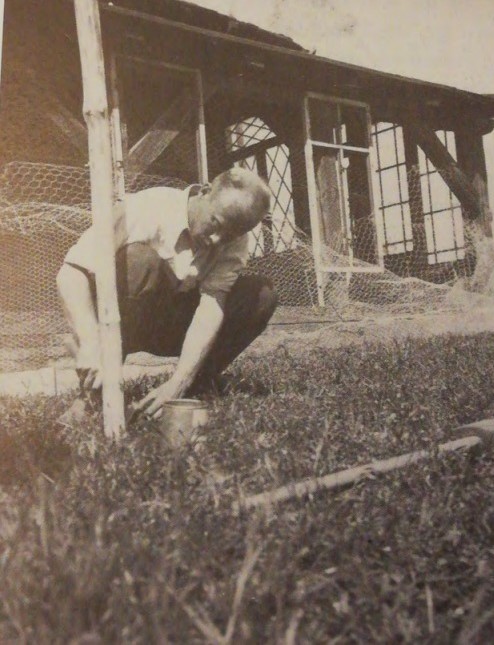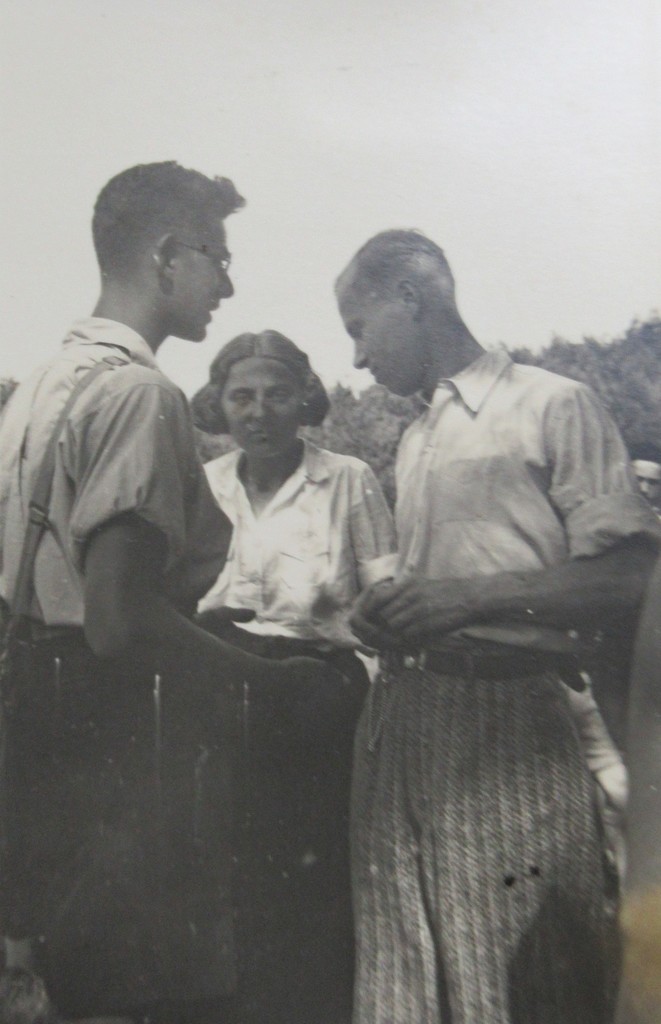- Also Known As
- Ligota Scinawska (heute)
- Type of Hakhshara
- Middle Hakhshara (Mi-Ha), regular Hakhshara
- Founded
- 1937
- Opened
- December 19, 1937
- Closed
- June 1941
- Operating Area
-
100 hectare
- Areas of Training Offered
-
horticulture, home economics, woodworking, agriculture, animal husbandrygardening (fruit, vegetables, asparagus); livestock farming (cattle, pigs, sheep, goats, pigeons, horses); poultry farming; home economics; canning; dairy production; arable farming (grain, potatoes, beets); carpentry
- Description
-
Starting in September 1937, work was begun developing the middle Hakhshara in Ellguth-Steinau at the initiative of the Reich Representation of German Jews and the HeHalutz. The estate belonged to the factory-owning Fränkel family of Neustadt, Upper Silesia. In his postdoctoral thesis, Hermann Meier-Cronemeyer refers to the site as the “showcase estate of the Reich Representation [sic]”. Accordingly, the 1937 work report of the Central Committee of the German Jews for Relief and Reconstuction (Zentralausschuss der Deutschen Juden für Hilfe und Aufbau) states: “In Ellguth, for the first time, we have taken over a large farm which, thanks to the state of its crops, the abundant infrastructure of livestock, machinery and other equipment, and the good condition of the buildings means that only a small amount of investment is necessary and, above all, offers the guarantee of such a favorable income from the agricultural operations that perhaps the caretaking fees could be lowered in time from the current rate of RM 45.00.”
The first director starting in November 1937 was Edgar Freund, a former teacher and Habonim leader from Breslau. Before he came to Ellguth, he had worked in the management of the Jewish Youth Welfare Association along with his wife Elly, who also came along to Ellguth with him. This exclusive leadership duo became a quartet with the arrival of Georg Josephthal and his partner Senta at the end of 1937. They were both from Franconia and had also belonged to the leadership of the Zionist Youth Movement before they came to the Hakhshara. Georg served as general secretary of HeHalutz and was in the merkaz of Habonim; Senta was active in the Jewish Youth Welfare Association. Both were also deeply involved in the conception and practical implementation of the middle Hakhshara or Mi-Ha. While Georg Josephthal was responsible for farming in Ellguth, Senta took care of the cows. Edgar Freund was responsible for the garden and Elly for housekeeping. Several of the halutzim in Ellguth knew the prominent Hakhshara leaders from their time in the youth leadership of the Habonim in Berlin. Agriculture, Palestine studies and Hebrew were taught every day in 20-minute lessons. In addition, there were lessons in science, physics, chemistry and biology. Alongside the halutzim and halutzot, there were also non-Jewish employees. In 1938 these were an inspector (Bless), an assistant inspector, a Swiss couple, three coachmen with their wives, a gardener, two office workers, a kitchen manager, an agriculture teacher and three other workers.
In the summer of 1938, the first group of senior members from Ellguth made Aliyah. Georg and Senta Josephthal left Ellguth in August 1938 after receiving a warning about Gestapo investigations; the Freunds followed them in September. The Josephthals and the Freunds were able to make Aliyah to Palestine. Their successor at the Hakhshara was Fritz Wolff. In April 1938, there were 55 halutzim and halutzot living in Ellguth; in May 1939 there were 90. The halutz Benno Teichmann wrote a report about the events before and during the November Pogrom in 1938. First, on October 28, 1938, all halutzim and halutzot with Polish passports were removed from the estate and deported to Poland. Some of them were able to return after a short time. On November 10th, two youths from Breslau came to the estate on a motorcycle to tell them what had happened in their town. That afternoon a gendarme arrived, but for the time being, he only searched for weapons. A mob of farmers and the SA came in the night and forced their way inside. They beat up and threatened the halutzim. Everyone who was still on the estate had to pack their bags and were taken in a truck to the police headquarters in Opole that same night. The young women were later released, while the young men were transported to the Buchenwald concentration camp. After a few weeks, all of the halutzim from Ellguth were released (as far as is known). They either left the country immediately or had to wait in Ellguth until they were offered a place in a Hakhshara in the Netherlands (usually in Werkdorp). In the 1940s, former participants in Ellguth were active in the resistance group of Joop Westerweel in the Netherlands, others were among the founders of the kibbutz Gal Ed in Palestine/Israel in 1945. There are no reliable depictions of the history of Ellguth from mid-1939-1941 or as a site for Jewish forced labor.

© Privatarchiv/Archiv der Jüdischen Jugendbewegung-TU Braunschweig

© Privatarchiv/Archiv der Jüdischen Jugendbewegung-TU Braunschweig

© Privatarchiv/Archiv der Jüdischen Jugendbewegung-TU Braunschweig
- Related Organizations
-
Habonim Noar Chaluzi (Deutschland) (associated)Hechaluz. Deutscher Landesverband (sponsor)Jüdischer Pfadfinderbund Makkabi Hazair (associated)
- Related Persons
-
Eger, Irene (sponsorship)Gerson, Bertel Beila Berthel (sponsorship)Gerson, Martin (sponsorship)Guttmann, Salo (sponsorship)Pinkus, Hans (sponsorship)Juliusburger, Egon (sponsorship)Kochmann, Arthur (sponsorship)Singer, Robert (sponsorship)Wolff, Adolf (sponsorship)
- Sources and Notes
-
Edgar Freund (1989). Chapters from his life (Privatdruck Israel)
Benno Teichmann: Hachscharakibbuz Ellguth Ende 1938, in: Yad Vashem Archives
Arbeitsbericht des Zentralausschuss Deutscher Juden für Hilfe und Aufbau, 1937, S. 83.
Mittleren Hachschara, Hrsg: Kurt Herzberg/ Hechaluz. Deutscher Landesverband [1937]
Gespräch KB mit Elly Freund, Bat Yam 2011
GFH Archiv, JHI Warschau, LBI-NY - Literature
-
Knut Bergbauer: Pioniere in der Provinz. Hachschara, Alija und jüdische Jugendbewegung in Schlesien, in: Ulrike Pilarczyk; Arne Homann; Ofer Ashkenazi (eds.), Hachschara und Jugend-Alija. Wege jüdischer Jugend nach Palästina 1918-1941, Steinhorster Beiträge zur Geschichte von Schule, Kindheit und Jugend. Gifhorn: Gemeinnützige Bildungs- und Kultur GmbH des Landkreises Gifhorn 2020. pp. 107–133.
Hubertus Fischer: Das Lehrgut Ellguth bei Steinau (1937–1941) und die Hachschara in Oberschlesien, in: Jahrbuch für die Geschichte Mittel- und Ostdeutschlands 64 (1) (2018). pp. 61–110. online: <https://www.degruyter.com/document/doi/10.1515/jgod-2018-0002/html>
Edgar Freund: Chapters from his life. Israel 1989.
Hermann Meier-Cronemeyer: Zwischen Nationalismus und Sozialismus. Die jüdische Jugendbewegung in Deutschland. Erlangen-Nürnberg 1977.
Eliyahu Kutti Salinger: "Nächstes Jahr im Kibbuz". Die chaluzische Jugendbewegung in Deutschland zwischen 1933 und 1943, Paderborner Beiträge zur politischen, wirtschaftlichen und kulturellen Weiterbildung : Neue Reihe. Paderborn: KoWAG Universität Paderborn 1998.
Andrea von Treuenfeld: Dr. Elly Freund, in: In Israel eine Jüdin, eine Jeckete in Israel. Geflohene Frauen erzählen ihr Leben. Gütersloh: Gütersloher Verlagshaus 2011. pp. 24–43.
Recommended Citation
Knut Bergbauer, Ellguth-Steinau, in: Hakhshara as a Place of Remembrance, December 12, 2022. <https://hachschara.juedische-geschichte-online.net/en/site/12> [December 28, 2025].